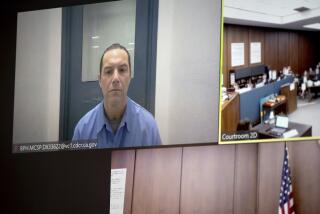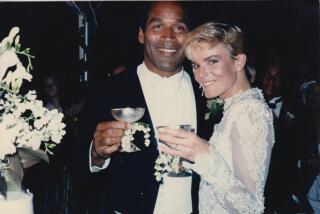Simpson Hearing Focus Is on Evidence Testing
- Share via
Skirmishing on the eve of a highly charged preliminary hearing, defense attorneys and prosecutors in the O.J. Simpson murder case squared off Tuesday over scientific tests being performed to determine whether the superstar athlete was at the scene of the bloody double homicide.
Simpson did not speak during Tuesday’s emergency hearing, the fourth court session since his arrest after an internationally televised pursuit June 17. Unshaven and seemingly detached, he glanced around the courtroom as his lawyer and representatives of the Los Angeles County district attorney’s office agreed on parameters for sharing certain evidence and conducting tests on it.
Simpson’s lawyer, Robert L. Shapiro, agreed Tuesday to provide prosecutors with a sample of his client’s hair for comparison with hair discovered in a blue knit cap found at the scene of the murders. Prosecutors have said in court papers that the hairs are “of African American origin” but have not linked them to Simpson.
While the hair samples are the latest disclosure of evidence in the case, much of the argument in Thursday’s preliminary hearing will focus on another body of forensic evidence--bloodstains. According to police sources, investigators have taken blood samples from the scene of the murders, from Simpson’s driveway, from inside his Ford Bronco and from a pair of dark brown work gloves, one found at the scene, the other outside his Brentwood home.
Police crime lab specialists already have run tests on some of those samples, and forensic evidence pointing to Simpson as the likely culprit is expected to be introduced by prosecutors at the preliminary hearing--at the end of which a judge will decide whether there is enough evidence to force Simpson to stand trial for the slayings of his ex-wife, Nicole Brown Simpson, and her friend Ronald Lyle Goldman.
Even as prosecutors prepared for Thursday’s hearing, police continued to hunt for more clues. Armed with a new search warrant, a team of officers descended on Simpson’s house late Tuesday, in part, sources said, to search for the missing murder weapon--a large knife that investigators in Los Angeles and Chicago have been unable to find.
The officers were accompanied by police dogs and were carrying metal detectors to aid in their search. Legal experts generally agree that while the prosecution’s case is unlikely to hinge on recovering the murder weapon, finding it would fill a hole in the case against Simpson that his attorneys can otherwise be expected to exploit.
With physical evidence apparently underlying much of the prosecution’s case, Shapiro on Tuesday asked Municipal Judge Kathleen Kennedy-Powell to direct prosecutors to split up blood samples so that Simpson’s experts can conduct their own tests--presumably to counter any results offered by prosecution witnesses. Shapiro said he was not satisfied by a prosecution offer to allow Simpson’s experts to observe while prosecution analysts performed the tests.
“We are entitled to conduct our own independent tests, not simply to sit and look over the shoulder of the district attorney and the LAPD crime lab,” Shapiro said. “It does us no good simply to watch what somebody else does.”
The judge agreed in part, and ordered prosecutors to share whatever samples they could. Deputy Dist. Atty. Marcia Clark, the lead prosecutor in the case, said government lawyers had no objection as long as the samples were large enough to split without jeopardizing the testing process.
“We have nothing that we have to hide from the defense,” said Clark, a theme she repeatedly emphasized during Tuesday’s brief hearing. “This case is an open book.”
In addition to blood samples, police discovered strands of hair in the blue knit cap found near the bodies. Once prosecutors obtain the samples of Simpson’s hair, they will be subjected to DNA analysis, like the bloodstains.
None of the DNA results will be part of the preliminary hearing. Instead, prosecutors expect to present results of a less rigorous blood testing process known as serology--one that scientific experts say can narrow the odds against two matching samples coming from different people to about 1 in 100.
DNA testing is far more exact, and prosecutors expect to complete those tests in time for Simpson’s trial, should there be one. But the standards are lower at a preliminary hearing, in which a judge must only decide whether there is enough evidence for a defendant to stand trial.
If even the less exacting tests point to Simpson as a likely suspect, legal experts said, they might satisfy the requirements of the preliminary hearing.
“It doesn’t take much to bind someone over,” said Harland W. Braun, a prominent Los Angeles defense attorney. “The preliminary hearing is so that a judge can quickly look at the evidence and make sure that there hasn’t been a mistake, not so that they can decide whether he’s guilty.”
The hair testing procedures are similar and could depend on the quality of samples taken from the scene, scientists said.
Microscopic examination of hair has extremely limited value in a criminal investigation, according to Dr. Paul R. Billings, a forensic expert at California Pacific Medical Center. DNA fingerprinting of hair samples can be much more effective, but only if there is enough DNA for accurate testing, he added.
The hair shaft--the part that protrudes above the skin--contains virtually no DNA and is essentially useless, Billings said. DNA is contained only in the root of the hair, the follicle.
Prosecutors said Tuesday that they have both hair shafts and follicles to examine. But analysis of a single hair, even if the root is present, is an “iffy” proposition, according Mark Stolorow, director of operations for Cellmark Ltd. in Germantown, Md., one of the leading laboratories in DNA fingerprinting. “Not all DNA tests on hair roots are going to give interpretable results because of the wide variations in DNA concentrations (in the roots). But there is at least an even chance that you can get an interpretable result.”
Because of the small amount of DNA present in the hair root, laboratories use a different analytical technique on hair. The method is slightly faster than conventional DNA fingerprinting--taking about four weeks, compared to eight to 10 weeks for conventional testing--but the results have so far been accepted in only a few courts, primarily in the East, Billings said.
Blood testing is generally more precise than the test performed on hair samples, and preliminary DNA tests on some of the blood samples already have been conducted. Although those results will not figure in the preliminary hearing, Kennedy-Powell ordered Clark to turn the results over to Shapiro.
In agreeing to do so, Clark noted that some tests have yet to be performed, in part because investigators have not had a chance to thoroughly examine all of the more than 60 pieces of evidence gathered. Clark said prosecutors expect to spend at least a week presenting their evidence at the preliminary hearing, and Shapiro has said that Simpson may offer a defense--an unusual tactic for a preliminary hearing that could greatly extend its length.
Former federal prosecutor John Shepard Wiley Jr., a UCLA law professor and an expert in evidence, said the blood test results that will figure prominently at the preliminary hearing may be important at that stage, but will not be “the main event” at a trial for Simpson if he is bound over.
“The DNA will definitely be the large prize the prosecution is seeking,” he said, while adding that the results also could turn against prosecutors if they point to another suspect. “The defense could establish that there was some human being other than O.J. Simpson at the murder scene. That’s not conclusive, but it is extremely powerful.”
As for the hair samples, Wiley said, they would provide powerful evidence only if the prosecution can show that the hat was left there during the crime and not during an earlier visit.
While the case heads to court for the first public unveiling of the evidence, much attention has focused on exactly when the murders occurred. Pinpointing the time is important to both sides because Simpson’s lawyers have said that he was at home when the killings occurred and that he could not have had time to commit the crimes and still be home in time to meet a limousine that arrived to take him to the airport for an 11:45 p.m. flight.
A coroner’s report suggested that Nicole Simpson was still alive and speaking to her mother on the telephone about 11 p.m. One of Simpson’s attorneys, F. Lee Bailey, quickly jumped on that information to assert that his client could not have committed the crime.
But the report was contradicted Monday by Nicole Simpson’s father, Louis Brown, who said the conversation actually occurred closer to 10 p.m.
Bailey, who has commented at length about the case in recent days, was unavailable Tuesday to respond to the comments by Nicole Simpson’s father. An assistant said he was halting all public statements for the time being.
Police Department officials would not comment on whether they have obtained phone records that would reveal the exact time of the call. Phone company officials also declined to discuss the issue in detail, even to confirm or deny whether they have received a search warrant for the records.
Larry Cox, state manager of public affairs for GTE California, said the company routinely complies with such court orders but that it usually takes at least five working days to produce the information. In very special circumstances, usually in cases involving criminal charges, the company also releases early billing information to the customer, he said.
“Otherwise, we are specifically precluded from releasing that information,” Cox said. “We take protecting our customers’ phone records very seriously.”
Times staff writers Thomas H. Maugh II, Henry Weinstein and Rebecca Trounson contributed to this story.
* SHELTERS TO GET FUNDS: City, county pledge $6.1 million to house abuse victims. A24
More to Read
Sign up for Essential California
The most important California stories and recommendations in your inbox every morning.
You may occasionally receive promotional content from the Los Angeles Times.














